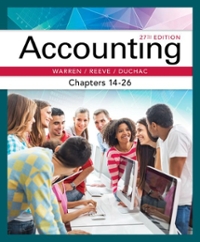Question
The following financial data are derived from the accounting system in the beginning of January: $Accounts receivable23,000 Inventory24,200 Cash (overdraft)(7,000) Dividend payable1,000 Equipment at cost80,000
The following financial data are derived from the accounting system in the beginning of January:
$Accounts receivable23,000
Inventory24,200
Cash (overdraft)(7,000)
Dividend payable1,000
Equipment at cost80,000
Accumulated depreciation19,200
Long-term note payable 14% 40,000
Share capital40,000
Retained earnings20,000
ABC company expects the following results during the second quarter of the year (next three months):
Jan
150,000 Sales
100,000 Purchases
20,000 Expenses includingdepreciation
Feb
200,000 Sales
150,000 Purchases
25,000 Expenses includingdepreciation
Mar
300,000 Sales
280,000 Purchases
30,000 Expenses includingdepreciation
The company generates all revenues from sales on account and is able to collect all outstanding balances. Its collection pattern is as follows:
80% is collected during the month of sales (a 4% discount is given for payment in this period); and
the remaining 20% is collected in the following month.
The company pays for its purchase made in the month of purchase in order to take advantage of a 10% settlement discount, calculated on the gross purchase amount presented above. Inventory levels are expected to remain constant throughout the quarter. There is no fluctuation in price when the company purchases its inventory. Depreciation rate of the equipment is 12% on cost per year. Expenses are recorded on a monthly basis. Expenses are paid for in the month in which they are incurred. The declared dividend will be paid in Jan. There is no repayment of the long-term note during the quarter. Interest on the note for the quarter will be paid in March.
What is the total cash receipts for the quarter?
What is the total cash payments for the quarter?
What is the cash balance at the end of the quarter?
What is the gross profit for the quarter?
What is the net profit for the quarter?
What is the total current assets at the end of the quarter?
What is the total non-current assets at the end of the quarter?
What is the total liabilities at the end of the quarter?
What is the total shareholders' equity at the end of the quarter
Step by Step Solution
There are 3 Steps involved in it
Step: 1

Get Instant Access to Expert-Tailored Solutions
See step-by-step solutions with expert insights and AI powered tools for academic success
Step: 2

Step: 3

Ace Your Homework with AI
Get the answers you need in no time with our AI-driven, step-by-step assistance
Get Started


